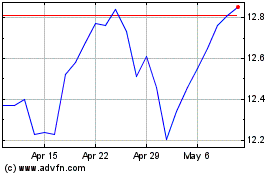How to Navigate the Fog of Sustainable Investing -- Heard on the Street
September 07 2020 - 5:46AM
Dow Jones News
By Stephen Wilmot
Can environmental, social and governance risks be quantified?
With the notable exception of carbon emissions, probably not -- but
that doesn't mean the exercise isn't useful for investors.
Interest in so-called sustainable investment is ballooning. One
sign is the money given to mutual funds: In the first half of 2020,
net flows into sustainable funds totaled $20.9 billion in the U.S.,
according to Morningstar, compared with $21.4 billion for 2019 as a
whole -- which was itself four times the previous record for a
calendar year.
Fund managers that don't specialize in ESG strategies are
scrambling to incorporate them into their investment frameworks.
There is an established industry of risk ratings, but these come
with a well-documented problem: The correlation between different
companies' ratings of the same stock is low because they measure
performance differently. An infamous example is Tesla. MSCI rates
the electric-car maker highly because of its environmentally
friendly products, while FTSE Russell gives it a middling score for
other reasons. This kind of confusion gives ESG ratings a
reputation for fuzziness.
Quantifying the risk to earnings from a given concern is a
pleasingly sharp-edged alternative. London-based fund manager
Schroders has developed a tool, SustainEx, to put a value on a
company's "externalities" -- the unpaid costs of its activity borne
by society. The rationale is that pressure is building on companies
to assume a greater share of these costs, which it estimated last
year at $2.2 trillion or 55% of corporate profits globally.
For example, SustainEx sees the tobacco sector as most at risk,
given the health problems caused by smoking. The market agrees:
After many years of stellar stock-market performance, tobacco
stocks have fallen from grace since 2017 as the U.S. Food and Drug
Administration has toughened its stance. Other conclusions, such as
the social risk to the earnings of highly rated alcoholic drinks
producers such as Diageo, are more surprising.
Such an approach has the advantage of bridging the gap between
ESG analysis and conventional stock analysis, which revolves around
earnings estimates. Some companies have made similar efforts:
Sportswear brand Puma has published a survey of what its products
cost the environment for almost a decade. Yogurt maker Danone this
year started to report earnings per share adjusted for its carbon
footprint.
Ultimately, though, putting a number on ESG risks isn't so
different from issuing a qualitative rating. Schroders used
academic studies to estimate costs in as objective a way as it
could, but another investor could package the same or other studies
differently and come up with different numbers.
"It would be nice to have comparability, but things are often
not comparable," says Alex Edmans, a finance professor at the
London Business School and author of " Grow the Pie: How Great
Companies Deliver Both Purpose and Profit." He usually prefers a
framework based on broad principles to a quantitative approach.
The real advantage of SustainEx for Schroders, which previously
used MSCI's ratings, is that having an in-house system allows ESG
factors to be better integrated into its existing processes. "We're
trying to help our investors think differently about the
ingredients that go into an investment decision," says Andy Howard,
global head of sustainable investment at Schroders.
One area where ESG risks can easily be compared is the carbon
emissions held responsible for climate change -- a problem that has
rapidly risen up the political agenda in recent years. Tougher
carbon cap-and-trade programs in particular could crystallize risks
to earnings identified in models such as SustainEx. Amid the
confusion around how to approach ESG factors, comparing companies'
carbon footprints is a good place to start.
Write to Stephen Wilmot at stephen.wilmot@wsj.com
(END) Dow Jones Newswires
September 07, 2020 05:31 ET (09:31 GMT)
Copyright (c) 2020 Dow Jones & Company, Inc.
Danone (QX) (USOTC:DANOY)
Historical Stock Chart
From Mar 2024 to Apr 2024

Danone (QX) (USOTC:DANOY)
Historical Stock Chart
From Apr 2023 to Apr 2024
